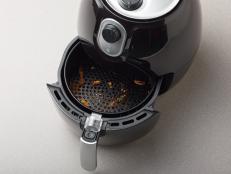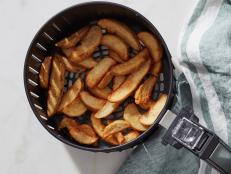What Do Food Pantries Really Need Right Now?
Food insecurity is still a problem for many Americans. Here's how to make your donations make the biggest difference.

mixetto/Getty Images
In 2019, 10% of Americans didn’t have access to enough nutritious foods to meet their needs, which is another way of saying that they were food insecure. Thanks to the effects of the ongoing COVID-19 pandemic, particularly higher rates of unemployment, that number has risen to 15%. In other words, nearly one in six Americans can’t get the food they need to eat a healthy diet.
Food insecurity is a complex issue. It’s rooted in poverty — people can’t access adequate fresh food if they can’t afford to buy it. It’s exacerbated by the fact that low-income neighborhoods typically have fewer grocery stores and less reliable public transportation, so residents also have less physical access. And, these issues disproportionately affect people of color, which means that Black and Hispanic Americans are twice as likely to be food insecure than non-Hispanic white Americans. Frankly, there’s no quick and easy solution to the problem; the only way to truly fight food insecurity is through big, systemic change.
All that said, there are small things you can do to help bring healthy food to people who wouldn’t have it otherwise. You can volunteer at a food bank, deliver meals to those in need, or donate to a program that’s working to make healthy school lunches available to students whose schools aren’t open. Probably the easiest way to help is to donate healthy food to your local food pantry. But before you go packing up whatever canned goods you have lying around, read up on what food pantries actually need (and don’t need) right now.
During this pandemic, the best thing to donate to a food bank is money.
First, a food bank isn’t the same thing as a food pantry. A food bank is a non-profit organization that stores (often millions of pounds of) food in large warehouses. Food banks regularly deliver this food to food pantries and other community distribution centers, where the food gets passed out. When you donate food or money, you generally donate to a food bank, which then distributes to local food pantries where food gets handed out.
At this point in the pandemic, most food banks are accepting food donations, so donating certain food items (more on that later) is great. Frankly, though, what food banks need most is money. Because food banks have direct relationships with food suppliers, they pay less for food than you do at the store. Your dollar literally goes further when you give it straight to a food bank instead of using it to buy food that you’ll donate. This is true all the time, not just in the midst of a global pandemic.
Of course, COVID-19 has brought new challenges to food banks. Feeding America’s COVID-19 Response Fund goes directly to food banks across the country who are spending more money than usual to operate as safely as possible. You can donate here.

Justin Sullivan/Getty Images
If you want to make a food donation, give nutritious, non-perishable items.
Your local food bank will likely accept almost any non-perishable food item, but here are the items that food banks want the most:
- Peanut butter
- Canned soup or stew
- Canned fruits and vegetables
- Canned fish
- Canned or dried beans
- Pasta (preferably whole grain)
- Rice (preferably brown rice)
If you’re donating canned goods, look for cans labeled "low-sodium" or "no added salt." Too much sodium increases a person’s risk for heart disease and stroke, and food insecure individuals may already be at higher risk. Also, stick to fruits and vegetables that are canned in water instead of syrup, or that are labeled "no added sugar." As too much sugar increases a person’s risk of type 2 diabetes, and makes it harder for people with type 2 diabetes to manage their blood sugar. And, again, people who are food insecure may already be at a higher risk.
Food banks do hand out fresh food, but you shouldn’t donate it.
According to Feeding America, the three most requested items at food banks and food pantries are dairy products like milk, cheese, and yogurt; fresh fruits and vegetables; and lean proteins like frozen chicken and canned tuna. But, because fresh food needs to be refrigerated or frozen and food banks have limited space for this, they often get fixed donations from nearby grocery stores instead of taking small donations from individuals. This also makes it easier for them to make sure that fresh food has been safely stored, which helps prevent spoiled or moldy food.
You can find your local food bank through Feeding America.
Obviously, food banks want you to be able to find them. Most have their own websites, and you can likely find several in your area by just Googling "food bank near me." You can also use Feeding America’s Find Your Food Bank tool, which maps local food banks and directs you to their website. The tool can also help you locate a local food pantry, if you’re looking to volunteer or are in need of food yourself.
Another thing to keep in mind is that different food banks have different needs, and these needs change over time. If your local food bank has a social media account, give them a follow and stay up-to-date on which items they do and don’t want at any moment.

Leon Neal/Getty Images
Because of COVID-19, many kids don’t have access to healthy school lunches, but you can help.
If you’ve ever wondered why people make such a big deal of healthy school lunches, it’s because one in six children don’t have regular access to healthy food at home — school lunch may be their main source of fruits, vegetables, and other healthy foods. COVID-19 has really thrown this for a loop, since many students are learning virtually instead of going to school in person.
If you want to help bring healthy lunches to kids who aren’t in school right now, the best thing to do is donate to No Kid Hungry, a national organization that’s working with schools and local groups to deliver healthy lunches or serve them in safe, communal spaces. You can donate here.
Bottom line: The best and safest way to give food to those in need is to donate to large organizations who know exactly what they’re doing.
Food insecurity has long been a problem in America, but the COVID-19 pandemic has made things worse. Significantly more people are food insecure now than before the pandemic. And since COVID-19 is a contagious virus, food banks and food pantries must spend more time and money on extra safety precautions. It’s complicated, to say the least. Because of all this, the best thing you can do is donate money to your local food bank, Feeding America, or No Kid Hungry. If you’d rather donate food, make sure to give healthy non-perishables, and to only do so if you don’t have any COVID-19 symptoms and have been following public health guidelines like wearing a mask and washing your hands.
Related Links:































































